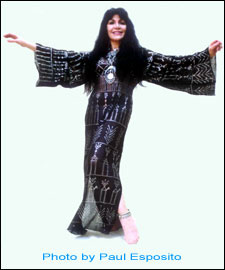Interview with Aisha Ali
by Salome Aisha Ali, a highly regarded performer, instructor, researcher and academic writer, is nothing less than legendary in the Oriental dance genre. Her field studies in the Middle East began in 1971 and continued until 1997. She has produced "Dances of North Africa Vol. I" (Morocco and Tunisia), as well as Dances of Egypt and she has released the first in a series of instructional videos "Dancing with Aisha". She has also produced six audio recordings from her pilgrimages and has published numerous works including a text she authored on Egypt for the current JVC/Smithsonian and her articles on Algeria and the Ouled Nail were published in the International Encyclopedia of Dance by the Oxford University Press.
Aisha Ali, a highly regarded performer, instructor, researcher and academic writer, is nothing less than legendary in the Oriental dance genre. Her field studies in the Middle East began in 1971 and continued until 1997. She has produced "Dances of North Africa Vol. I" (Morocco and Tunisia), as well as Dances of Egypt and she has released the first in a series of instructional videos "Dancing with Aisha". She has also produced six audio recordings from her pilgrimages and has published numerous works including a text she authored on Egypt for the current JVC/Smithsonian and her articles on Algeria and the Ouled Nail were published in the International Encyclopedia of Dance by the Oxford University Press.She has performed through out the U.S., Europe and the Middle East. She frequently appeared with the Banat Mazin (a famous Ghawazee family), in festivities in the Thebes area of Upper Egypt. Aisha was also featured as a soloist in Tunisia at the Municipal Theater in Sfax and was asked to form a dance troupe there through the Maison de la Culture. For more than 20 years she has directed and choreographed for her own folkloric dance group, The Aisha Ali Dance Company.
Aisha conducts workshops and master classes throughout North America, Europe, as well as New Zealand, Australia and Hawaii. She occasionally lectures at UCLA in both the Music and Dance department and offers classes at her Los Angeles studio.
Salome: You have had an extensive career performing through out North Africa. How were you received as a foreign dancer?
Aisha: I was generally well received. Being of Middle Eastern background with a firm understanding of various Arab cultures was a great advantage and being an American and therefore "exotic" enough to be interesting also helped.
Salome: While many maintain an avid interest in Oriental and folk dances from the Near and Middle East not many make the pilgrimage. What drove you to return so many times?
Aisha: As a performer, I became addicted to the higher status that I enjoyed in the Middle East, and as a field worker, I formed a bond with the folk musicians and dancers that I filmed and recorded, and felt impelled to learn more about them.
Salome: For those who teach and perform, how important is it to study the various dances in their root countries?
Aisha: To me it has always been very important. A deep understanding of the music and movements from each region, combined with a knowledge of their histories, is what gives a dancer the freedom to be truly creative without stepping outside of the established traditions.
Salome: What are your thoughts on creating a universal dance vocabulary, and certification system? And what body of people do you think should guide that process?
Aisha: I think that a universal dance vocabulary is something that we need. I made several attempts to teach a certification program but was not entirely successful. Now I realize that it would require a lot more thought, planning, and commitment on both the part of the teachers and the students. Selecting a body of people to guide that process might be difficult. There are so many points of view, and the strong self promoters who command the most attention are not always the best qualified.
Salome: You have documented, produced, and published invaluable works. Can you name some of these projects and where to purchase them?
Aisha: There are six CD's: Both Music of the Ghawazee and Music of the Fellahin, feature a collection of gypsy and Saaidi music from Upper Egypt. Music of the Ouled Nail was collected among the tribes of that name in various parts of Algeria. Music for the Oriental Dance gives examples of full length oriental dances from Cairo, Alexandria and Luxor. I was careful to only record traditional instrumentation in order to preserve the older style of raqs sharqi. Tunisian Dances has a variety of Tunisian dance music from different regions, as well as some haunting hadra songs for the bride about to leave her Father's home. The latest, Tunisian Rhythms. Gives examples of each of the Tunisian drum rhythms long enough for dancers to learn them and practice movements with them. the drum patterns are followed by a selection of dance musicals. The album goes well with the video by the same name. They are available for purchase on the ARAF audio and video pages at http://aisha-ali.com